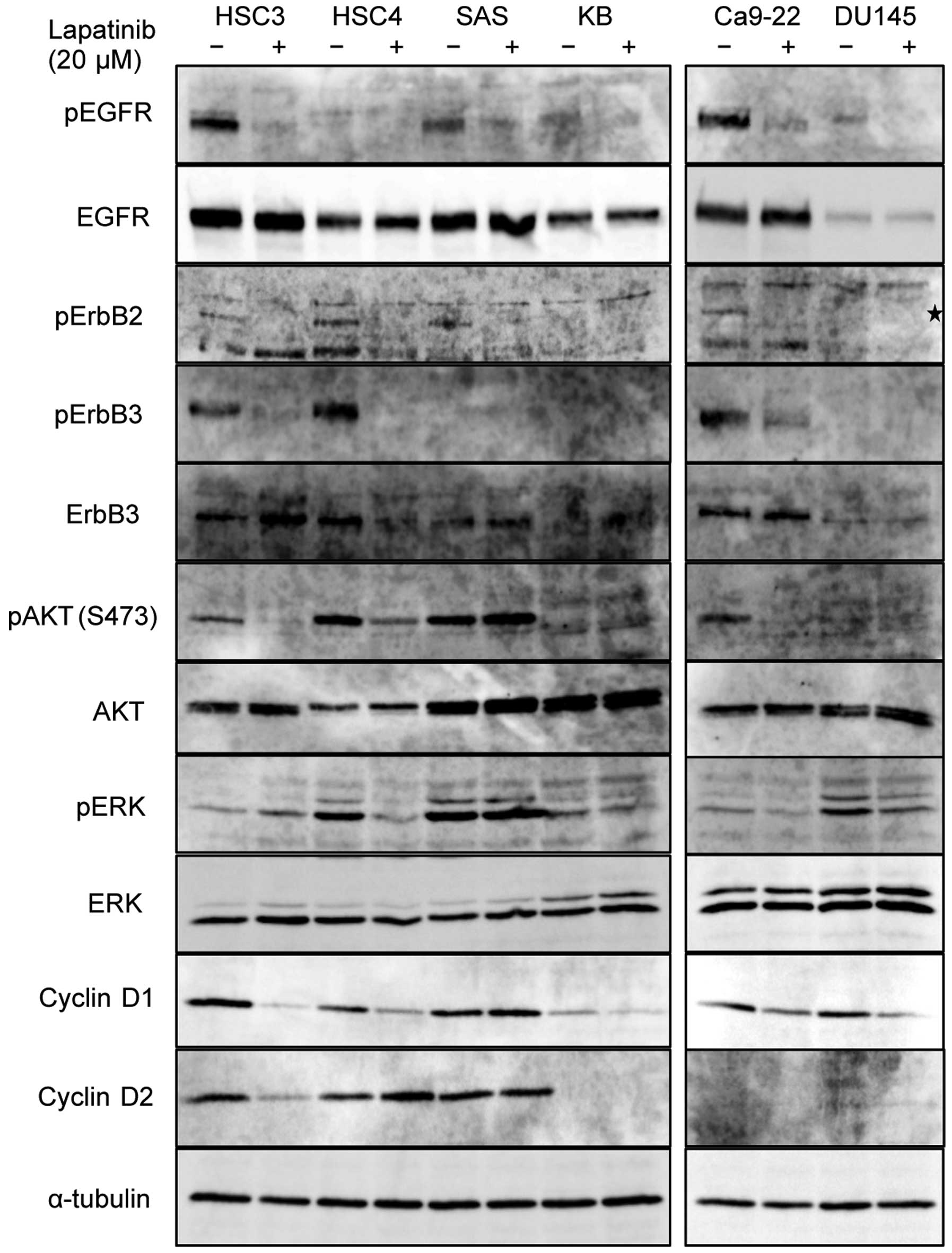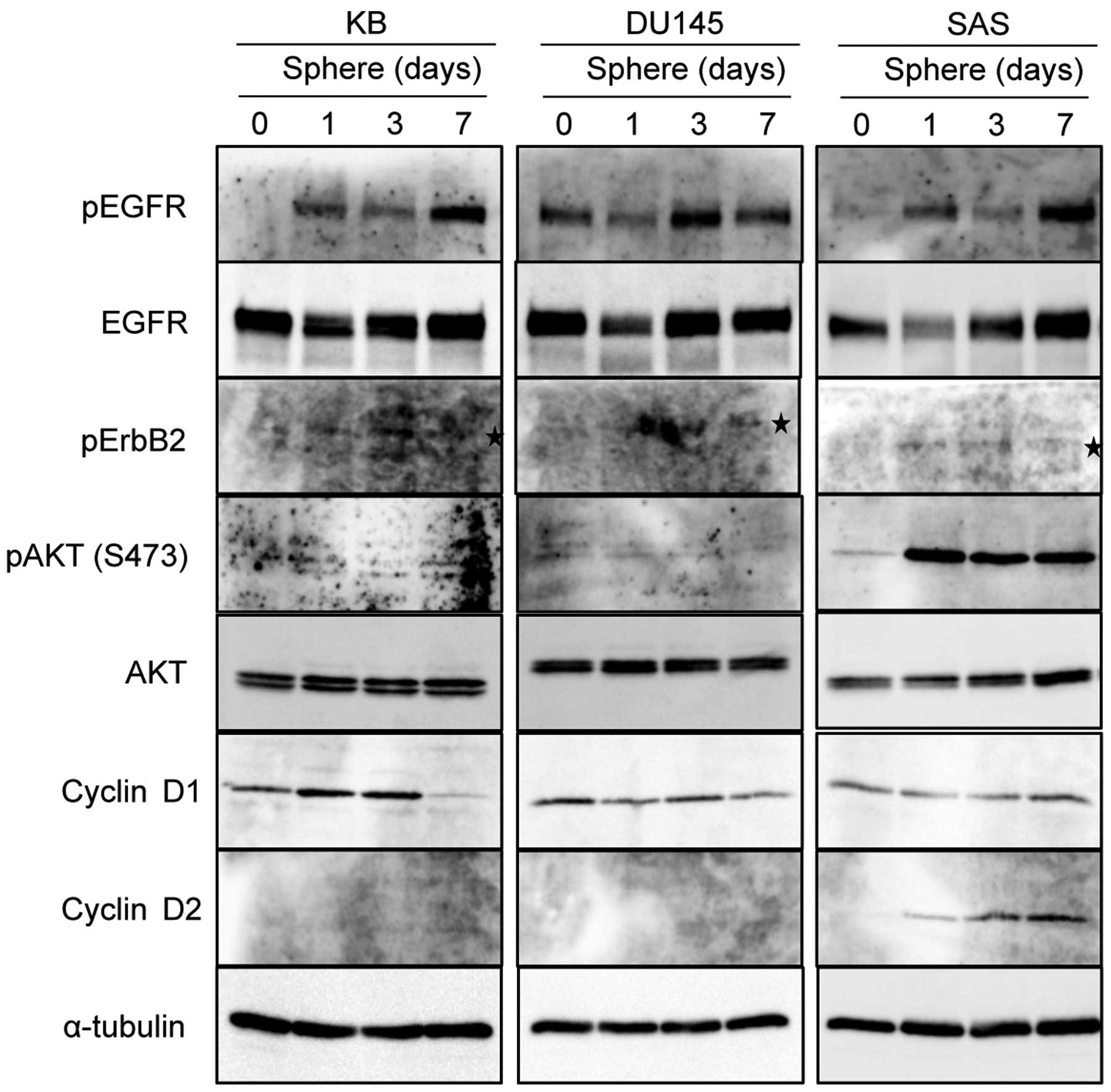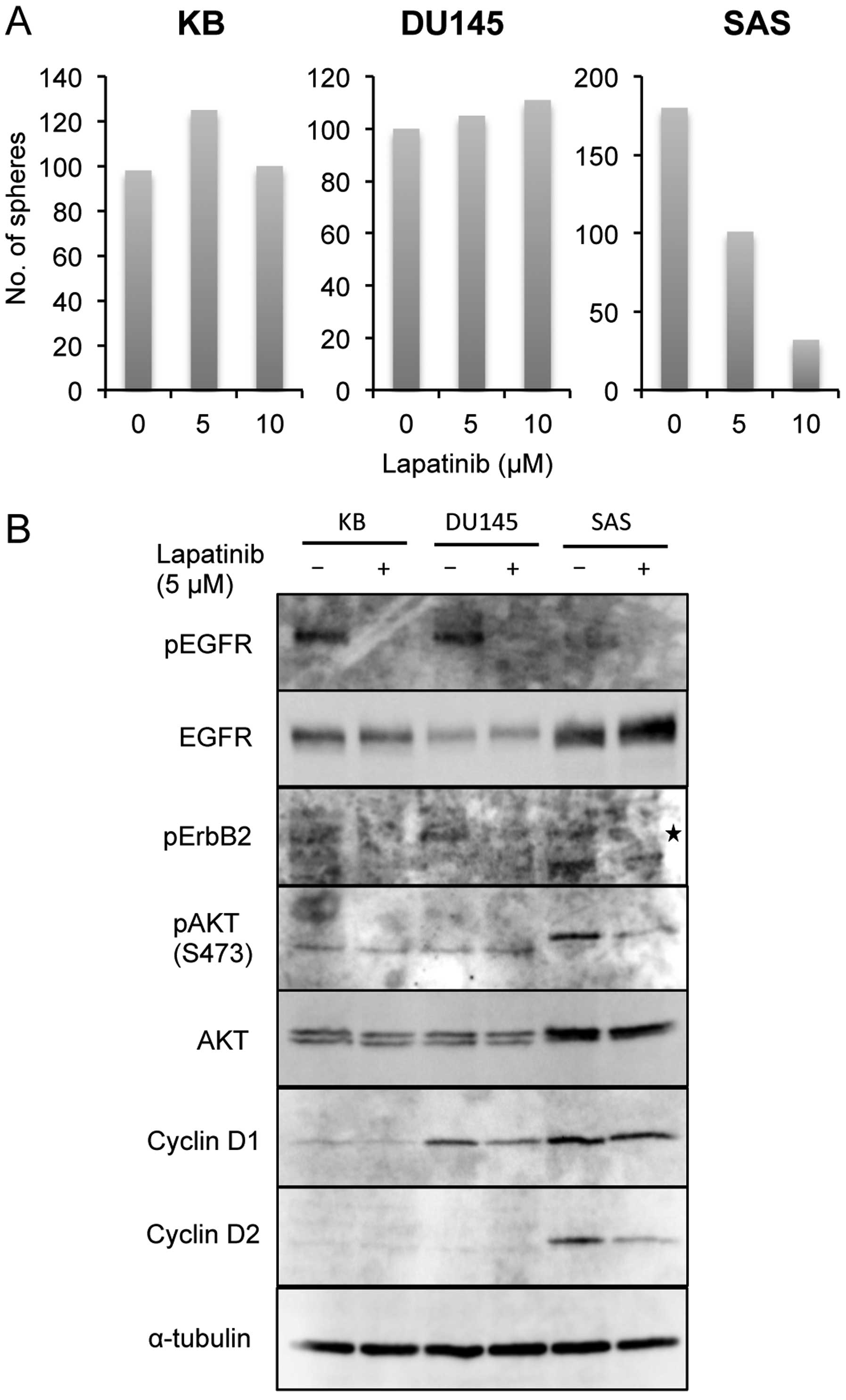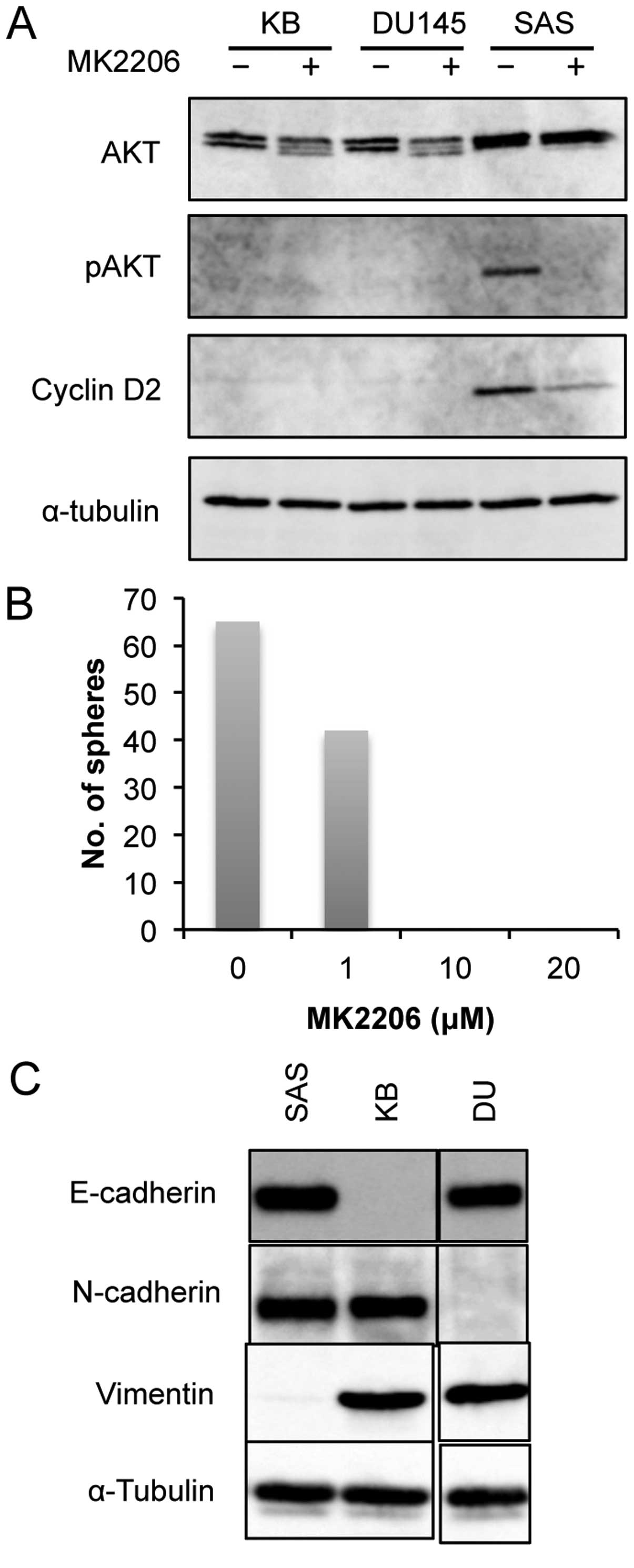|
1
|
Olayioye MA, Neve RM, Lane HA and Hynes
NE: The ErbB signaling network: Receptor heterodimerization in
development and cancer. EMBO J. 19:3159–3167. 2000. View Article : Google Scholar : PubMed/NCBI
|
|
2
|
Schlessinger J: Cell signaling by receptor
tyrosine kinases. Cell. 103:211–225. 2000. View Article : Google Scholar : PubMed/NCBI
|
|
3
|
Yarden Y and Sliwkowski MX: Untangling the
ErbB signalling network. Nat Rev Mol Cell Biol. 2:127–137. 2001.
View Article : Google Scholar : PubMed/NCBI
|
|
4
|
Herbst RS and Langer CJ: Epidermal growth
factor receptors as a target for cancer treatment: The emerging
role of IMC-C225 in the treatment of lung and head and neck
cancers. Semin Oncol. 29(Suppl 4): S27–S36. 2002. View Article : Google Scholar
|
|
5
|
Kris MG, Natale RB, Herbst RS, Lynch TJ
Jr, Prager D, Belani CP, Schiller JH, Kelly K, Spiridonidis H,
Sandler A, et al: Efficacy of gefitinib, an inhibitor of the
epidermal growth factor receptor tyrosine kinase, in symptomatic
patients with non-small cell lung cancer: A randomized trial. JAMA.
290:2149–2158. 2003. View Article : Google Scholar : PubMed/NCBI
|
|
6
|
Cohen MH, Johnson JR, Chen YF, Sridhara R
and Pazdur R: FDA drug approval summary: Erlotinib (Tarceva)
tablets. Oncologist. 10:461–466. 2005. View Article : Google Scholar : PubMed/NCBI
|
|
7
|
Maheswaran S, Sequist LV, Nagrath S, Ulkus
L, Brannigan B, Collura CV, Inserra E, Diederichs S, Iafrate AJ,
Bell DW, et al: Detection of mutations in EGFR in circulating
lung-cancer cells. N Engl J Med. 359:366–377. 2008. View Article : Google Scholar : PubMed/NCBI
|
|
8
|
Minguet J, Smith KH and Bramlage P:
Targeted therapies for treatment of non-small cell lung cancer -
Recent advances and future perspectives. Int J Cancer.
138:2549–2561. 2016. View Article : Google Scholar
|
|
9
|
Kokai Y, Myers JN, Wada T, Brown VI, LeVea
CM, Davis JG, Dobashi K and Greene MI: Synergistic interaction of
p185c-neu and the EGF receptor leads to transformation of rodent
fibroblasts. Cell. 58:287–292. 1989. View Article : Google Scholar : PubMed/NCBI
|
|
10
|
Di Fiore PP, Pierce JH, Fleming TP, Hazan
R, Ullrich A, King CR, Schlessinger J and Aaronson SA:
Overexpression of the human EGF receptor confers an EGF-dependent
transformed phenotype to NIH 3T3 cells. Cell. 51:1063–1070. 1987.
View Article : Google Scholar : PubMed/NCBI
|
|
11
|
Zhou Y, Li S, Hu YP, Wang J, Hauser J,
Conway AN, Vinci MA, Humphrey L, Zborowska E, Willson JK, et al:
Blockade of EGFR and ErbB2 by the novel dual EGFR and ErbB2
tyrosine kinase inhibitor GW572016 sensitizes human colon carcinoma
GEO cells to apoptosis. Cancer Res. 66:404–411. 2006. View Article : Google Scholar : PubMed/NCBI
|
|
12
|
Gomez HL, Doval DC, Chavez MA, Ang PC,
Aziz Z, Nag S, Ng C, Franco SX, Chow LW, Arbushites MC, et al:
Efficacy and safety of lapatinib as first-line therapy for
ErbB2-amplified locally advanced or metastatic breast cancer. J
Clin Oncol. 26:2999–3005. 2008. View Article : Google Scholar : PubMed/NCBI
|
|
13
|
Esteva FJ, Yu D, Hung MC and Hortobagyi
GN: Molecular predictors of response to trastuzumab and lapatinib
in breast cancer. Nat Rev Clin Oncol. 7:98–107. 2010. View Article : Google Scholar
|
|
14
|
Liu L, Greger J, Shi H, Liu Y, Greshock J,
Annan R, Halsey W, Sathe GM, Martin AM and Gilmer TM: Novel
mechanism of lapatinib resistance in HER2-positive breast tumor
cells: Activation of AXL. Cancer Res. 69:6871–6878. 2009.
View Article : Google Scholar : PubMed/NCBI
|
|
15
|
Xia W, Bacus S, Husain I, Liu L, Zhao S,
Liu Z, Moseley MA III, Thompson JW, Chen FL, Koch KM, et al:
Resistance to ErbB2 tyrosine kinase inhibitors in breast cancer is
mediated by calcium-dependent activation of RelA. Mol Cancer Ther.
9:292–299. 2010. View Article : Google Scholar : PubMed/NCBI
|
|
16
|
Zoppoli G, Moran E, Soncini D, Cea M,
Garuti A, Rocco I, Cirmena G, Grillo V, Bagnasco L, Icardi G, et
al: Ras-induced resistance to lapatinib is overcome by MEK
inhibition. Curr Cancer Drug Targets. 10:168–175. 2010. View Article : Google Scholar : PubMed/NCBI
|
|
17
|
Martin AP, Mitchell C, Rahmani M, Nephew
KP, Grant S and Dent P: Inhibition of MCL-1 enhances lapatinib
toxicity and overcomes lapatinib resistance via BAK-dependent
autophagy. Cancer Biol Ther. 8:2084–2096. 2009. View Article : Google Scholar : PubMed/NCBI
|
|
18
|
Martin AP, Miller A, Emad L, Rahmani M,
Walker T, Mitchell C, Hagan MP, Park MA, Yacoub A, Fisher PB, et
al: Lapatinib resistance in HCT116 cells is mediated by elevated
MCL-1 expression and decreased BAK activation and not by ERBB
receptor kinase mutation. Mol Pharmacol. 74:807–822. 2008.
View Article : Google Scholar : PubMed/NCBI
|
|
19
|
Creedon H, Gómez-Cuadrado L, Tarnauskaitė
Ž, Balla J, Canel M, MacLeod KG, Serrels B, Fraser C,
Unciti-Broceta A, Tracey N, et al: Identification of novel pathways
linking epithelial-to-mesenchymal transition with resistance to
HER2-targeted therapy. Oncotarget. 7:11539–11552. 2016.PubMed/NCBI
|
|
20
|
Ohnishi Y, Yasui H, Kakudo K and Nozaki M:
Cetuximab-resistant oral squamous cell carcinoma cells become
sensitive in anchorage-independent culture conditions through the
activation of the EGFR/AKT pathway. Int J Oncol. 47:2165–2172.
2015.PubMed/NCBI
|
|
21
|
Farnie G, Johnson RL, Williams KE, Clarke
RB and Bundred NJ: Lapatinib inhibits stem/progenitor proliferation
in preclinical in vitro models of ductal carcinoma in situ (DCIS).
Cell Cycle. 13:418–425. 2014. View
Article : Google Scholar :
|
|
22
|
Caldon CE, Daly RJ, Sutherland RL and
Musgrove EA: Cell cycle control in breast cancer cells. J Cell
Biochem. 97:261–274. 2006. View Article : Google Scholar
|
|
23
|
Lange CA and Yee D: Killing the second
messenger: Targeting loss of cell cycle control in
endocrine-resistant breast cancer. Endocr Relat Cancer. 18:C19–C24.
2011. View Article : Google Scholar : PubMed/NCBI
|
|
24
|
Tsai JH and Yang J: Epithelial-mesenchymal
plasticity in carcinoma metastasis. Genes Dev. 27:2192–2206. 2013.
View Article : Google Scholar : PubMed/NCBI
|
|
25
|
Rusnak DW, Lackey K, Affleck K, Wood ER,
Alligood KJ, Rhodes N, Keith BR, Murray DM, Knight WB, Mullin RJ,
et al: The effects of the novel, reversible epidermal growth factor
receptor/ErbB-2 tyrosine kinase inhibitor, GW2016, on the growth of
human normal and tumor-derived cell lines in vitro and in vivo. Mol
Cancer Ther. 1:85–94. 2001.
|
|
26
|
Spector NL, Xia W, Burris H III, Hurwitz
H, Dees EC, Dowlati A, O'Neil B, Overmoyer B, Marcom PK, Blackwell
KL, et al: Study of the biologic effects of lapatinib, a reversible
inhibitor of ErbB1 and ErbB2 tyrosine kinases, on tumor growth and
survival pathways in patients with advanced malignancies. J Clin
Oncol. 23:2502–2512. 2005. View Article : Google Scholar : PubMed/NCBI
|
|
27
|
Trowe T, Boukouvala S, Calkins K, Cutler
RE Jr, Fong R, Funke R, Gendreau SB, Kim YD, Miller N, Woolfrey JR,
et al: EXEL-7647 inhibits mutant forms of ErbB2 associated with
lapatinib resistance and neoplastic transformation. Clin Cancer
Res. 14:2465–2475. 2008. View Article : Google Scholar : PubMed/NCBI
|
|
28
|
Kancha RK, von Bubnoff N, Bartosch N,
Peschel C, Engh RA and Duyster J: Differential sensitivity of ERBB2
kinase domain mutations towards lapatinib. PLoS One. 6:e267602011.
View Article : Google Scholar : PubMed/NCBI
|
|
29
|
Dontu G, Abdallah WM, Foley JM, Jackson
KW, Clarke MF, Kawamura MJ and Wicha MS: In vitro propagation and
transcriptional profiling of human mammary stem/progenitor cells.
Genes Dev. 17:1253–1270. 2003. View Article : Google Scholar : PubMed/NCBI
|
|
30
|
Singh SK, Hawkins C, Clarke ID, Squire JA,
Bayani J, Hide T, Henkelman RM, Cusimano MD and Dirks PB:
Identification of human brain tumour initiating cells. Nature.
432:396–401. 2004. View Article : Google Scholar : PubMed/NCBI
|
|
31
|
Ponti D, Costa A, Zaffaroni N, Pratesi G,
Petrangolini G, Coradini D, Pilotti S, Pierotti MA and Daidone MG:
Isolation and in vitro propagation of tumorigenic breast cancer
cells with stem/progenitor cell properties. Cancer Res.
65:5506–5511. 2005. View Article : Google Scholar : PubMed/NCBI
|
|
32
|
Ricci-Vitiani L, Lombardi DG, Pilozzi E,
Biffoni M, Todaro M, Peschle C and De Maria R: Identification and
expansion of human colon-cancer-initiating cells. Nature.
445:111–115. 2007. View Article : Google Scholar
|
|
33
|
Eramo A, Lotti F, Sette G, Pilozzi E,
Biffoni M, Di Virgilio A, Conticello C, Ruco L, Peschle C and De
Maria R: Identification and expansion of the tumorigenic lung
cancer stem cell population. Cell Death Differ. 15:504–514. 2008.
View Article : Google Scholar
|
|
34
|
Han ME, Jeon TY, Hwang SH, Lee YS, Kim HJ,
Shim HE, Yoon S, Baek SY, Kim BS, Kang CD, et al: Cancer spheres
from gastric cancer patients provide an ideal model system for
cancer stem cell research. Cell Mol Life Sci. 68:3589–3605. 2011.
View Article : Google Scholar : PubMed/NCBI
|
|
35
|
Yu M, Bardia A, Wittner BS, Stott SL, Smas
ME, Ting DT, Isakoff SJ, Ciciliano JC, Wells MN, Shah AM, et al:
Circulating breast tumor cells exhibit dynamic changes in
epithelial and mesenchymal composition. Science. 339:580–584. 2013.
View Article : Google Scholar : PubMed/NCBI
|
|
36
|
Beerling E, Seinstra D, de Wit E, Kester
L, van der Velden D, Maynard C, Schäfer R, van Diest P, Voest E,
van Oudenaarden A, et al: Plasticity between epithelial and
mesenchymal states unlinks EMT from metastasis-enhancing stem cell
capacity. Cell Rep. 14:2281–2288. 2016. View Article : Google Scholar : PubMed/NCBI
|














